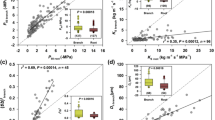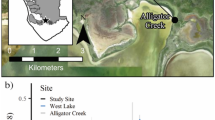Abstract
To elucidate tree breakage conditions with different breaking mechanisms, i.e., moment by drag force, local scour, and degradation of the substrate around trees, field surveys were conducted after a flood event (September 2007 flood due to Typhoon 9) in the Tamagawa River, Japan. Trees in a river have two main breaking mechanisms during a flood event, moment by fluid force and erosion of the substrate. Moment by fluid force causes two breaking phenomena, trunk damage (bending, breakage) and overturning. Trunk bending or breakage can be expressed as a function of d c, where d is the trunk diameter at breast height and the power c equals 3 for trunk bending or breakage, and approximately 2 for overturning. Smaller diameter trees experienced trunk breakage, but larger trees were overturned. The range for these two breaking patterns changes with the substrate condition. If severe scouring has occurred, the threshold for overturning moment can be quite small. Tree overturning occurred mostly on the bank side of the gravel bar; however, some trees, especially Robinia pseudo acacia and Morus bombycis, were overturned if the substrate was a thin deposited soil or silt layer on gravel. The roots were anchored in the small-particle deposited layer in that case. As for the erosion of the substrate, the tree-breaking patterns can be classified into three types depending on the relationship between the nondimensionalized bed shear stress of d 50 and d 84, the representative grain diameters at which 50 and 84% of the volume of the material, respectively, is finer. The nondimensionalized shear stress of d 84 is an important parameter for discussing the rehabilitation of the gravel bed bar. The boundary region for tree overturning can be changed by the effects of plant cover and debris attachment.










Similar content being viewed by others
References
Armanini A, Righetti M, Grisenti P (2005) Direct measurement of vegetation resistance in prototype scale. J Hydraul Res 43:481–487
Baker CJ (1980) The turbulent horseshoe vortex. J Wind Eng Ind Aerodyn 6:9–23
Blizard CR, Wohl EE (1998) Relationships between hydraulic variables and bedload transport in a subalpine channel, Colorado Rocky Mountains. USA Geomorphol 22:359–371
Breusers HNC, Nicollet G, Shen HW (1977) Local scour around cylindrical piers. J Hydraul Res 15:211–252
Egiazaroff JV (1965) Calculation of nonuniform sediment concentrations. Proc Am Soc Civil Eng 91(4):225–247
Einstein HA (1950) The bed-load function for sediment transportation in open channel flows. USDA Tech Bull 1026:71
Fukuoka S, Fujita K (1990) Hydraulic effects of luxuriant vegetations on flood flow (in Japanese with English abstract). Rep PWRI 180(3):64
Gardiner B, Peltola H, Kellomäki S (2000) Comparison of two models for predicting the critical wind speeds required to damage coniferous trees. Ecol Model 129:1–23
Graf WH (1984) Hydraulics of sediment transport. Water Resources Publications, Littleton, CO, pp 97
Graf WL (1978) Fluvial adjustments to the spread of tamarisk in the Colorado Plateau region. Geol Soc Am Bull 89:1491–1501
Kouwen N, Fathi-Morgan M (2000) Friction factors for coniferous trees along rivers. J Hydraul Eng 126(10):732–740
Maekawa M, Nakagoshi N (1997) Riparian landscape changes over a period of 46 years, on the Azusa River in Central Japan. Landsc Urban Plan 37:37–43
Melville BW, Dongol DM (1992) Bridge pier scour with debris accumulation. J Hydraul Eng 118(9):1306–1310
Melville BW, Sutherland AJ (1988) Design method for local scour at bridge piers. J Hydraul Eng 114(10):1210–1226
Okamoto S, Sunabashiri Y (1992) Vortex shedding from a circular cylinder of finite length placed on a ground plane. Trans ASME J Fluids Eng 114:512–521
Oswalt SN, King SL (2005) Channelization and floodplain forests: impacts of accelerated sedimentation and valley plug formation on floodplain forests of the Middle Fork Forked Deer River, Tennessee, USA. For Ecol Manag 215:69–83
Otto GH (1939) A modified logarithmic probability graph for the interpretation of mechanical analyses of sediments. J Sediment Petrol 9(2):62–72
Parsons DA (1963) Vegetative control of streambank erosion. In: Proceedings of Federal Interagency Sedimentation Conference. Miscellaneous publication 970. U.S. Department of Agriculture, Washington, DC, pp 130–136
Petryk S, Bosmajian GB (1975) Analysis of flow through vegetation. J Hydraul Div ASCE 101(7):871–884
Pollen N (2007) Temporal and spatial variability in root reinforcement of streambanks: accounting for soil shear strength and moisture. Catena 69:197–205
Raudkivi AJ, Ettema R (1983) Clear-water scour at cylindrical piers. J Hydraul Eng 109(3):338–350
Takemura T, Tanaka N (2007) Flow structures and drag characteristics of a colony-type emergent roughness model mounted on a flat plate in uniform flow. Fluid Dyn Res 39:694–710
Tanaka N, Kitakami Y, Ogawa T, Asaeda T (2004) Effect of stem-breaking caused by flood on the transition of wetland vegetation in old river trace. In: Proceedings of the 4th ISEH/14th IAHR-APD, pp 1555–1562
Tanaka N, Sasaki Y, Mowjood MIM (2006), Effects of sand dune and vegetation in the coastal area of Sri Lanka at the Indian Ocean tsunami. In: Namsik P et al (eds) Advances in Geosciences, vol 6. World Scientific, Singapore
Tanaka N, Sasaki Y, Mowjood MIM, Jinadasa KBSN (2007) Coastal vegetation structures and their functions in tsunami protection: experience of the recent Indian Ocean tsunami. Landsc Ecol Eng 3:33–45
Technology Research Center for Riverfront Development (TRCRD) (1994) Guideline for tree management in rivers (in Japanese). Sankaidou, pp 154–160
Tosi M (2007) Root tensile strength relationships and their slope stability implications of three shrub species in the Northern Apennines (Italy). Geomorphology 87:268–283
Wallerstein NP, Thorne CR (2004) Influence of large woody debris on morphological evolution of incised, sand-bed channels. Geomorphology 57:53–73
Wyzga B (2001) Impact of the channelization-induced incision of the Skawa and Wisloka Rivers, southern Poland, on the conditions of overbank deposition. Regul Rivers Res Manag 17:85–100
Acknowledgments
This study is partly funded by the Foundation of River & Watershed Environment Management (FOREM). Prof. Fukuoka, Chuo University, and Prof. Sasaki, Saitama University, are acknowledged for their useful suggestions. The authors would like to thank Mr. Nagai and Mr. Ito for their help in field measurements.
Author information
Authors and Affiliations
Corresponding author
Rights and permissions
About this article
Cite this article
Tanaka, N., Yagisawa, J. Effects of tree characteristics and substrate condition on critical breaking moment of trees due to heavy flooding. Landscape Ecol Eng 5, 59–70 (2009). https://doi.org/10.1007/s11355-008-0060-5
Received:
Revised:
Accepted:
Published:
Issue Date:
DOI: https://doi.org/10.1007/s11355-008-0060-5




